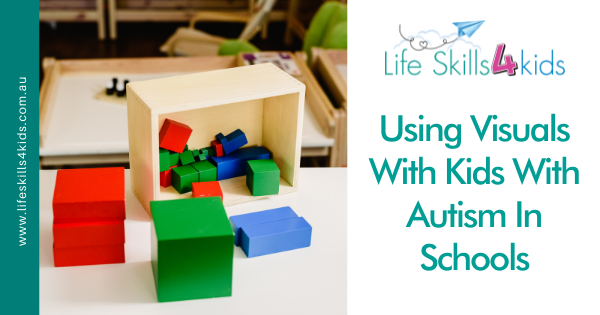All young people, especially those with autism, need to find ways to be able to communicate and make sense of their world. If kids are unable to make their needs known it can lead to behaviour problems, withdrawal and being misunderstood in everything they do. Over the years, schools have looked for effective ways to find a path into the world of each student.
The psychologist, Albert Maslow, in his Hierarchy of Needs clearly suggests that as an individual a sense of safety, security and belonging are fundamental components of human development. Visual supports can go a long way to facilitating this, through enabling the young person to have a communication system which can be understood by all of the people in that young person’s space (both at school and at home).
7 Visual Supports That Can Help Kids With Autism in Schools
- Objects of Reference/Tactile Symbols:
Actual objects that relate to the activity, so that the student knows what is about to happen. Examples include, armbands for swimming; the student’s cup for a drink; bells or a tambourine for music; a paint brush for art. Sometimes it can be difficult to find meaningful objects for a student, in these cases, an object can be chosen which relates to an activity but is not exactly showing the activity, for example, a candle for assembly. This ‘related’ object can be a useful cue as long as it is ALWAYS the same, so that the student can learn to anticipate what will happen by seeing the related object. - Plain squares of coloured card:
A piece of coloured card can be used to convey a single message, for example, a traffic light system can be used to give a young person an idea of beginning(green), five minutes to go (yellow), activity is ended/stopped (red). This can also be made more visual by using a five minute sand timer when the yellow card is produced, so that the student can see the sand going down as the time reduces. Sand timers can be purchased in different time frames (eg, 1 minute; 5 minutes; 10 minutes). - Signs and symbols:
There are different branded signs and symbols that can be used, for example, Key Word Sign Australia, Makaton, Widgit. These signs/symbols often have a natural gesture accompanying them. They all enable a student to see a visual representation of an activity, so that the student can make sense of their environment. It is important to have a whole school policy as to which specific set of signs/symbols is used and also to agree whether as a whole school the signs/symbols will be in black & white or colour. With my experience, I would personally recommend black & white symbols for autistic kids – they are already coping with a world that often does not make sense and I have found adding colour to symbols does not help. (I would save colour for photo and book images). It is also vitally important to agree on a school-wide sign/symbol for “Surprise”, so that a student can become aware that something out of the ordinary might be happening in their day, (for example rehearsing for a Christmas play or going on a special day trip). - Visual timetable:
Once the signs/symbols have been agreed in school, the symbols can then be used to create a visual timetable to allow a young person to have a sense of what is happening in their day. Some autistic students can cope with a class timetable which shows them what is happening as a whole class (this could be set out sequentially for all day, or for morning and then for afternoon; whilst others benefit from an individualised timetable with their own set of symbols on it, so that they can remove symbols each time they have completed an activity to know that they have finished and are moving onto whatever is next.) - Now-Next:
A simple Now/Next board can be created for an individual, which has the symbol on it for what is happening Now and the symbol for what is happening Next. This can help a student to tolerate what is happening now (for example, a work activity) because they know that next will be an activity they enjoy (for example, iPad). - Task sequence instructions strips:
Kids with autism can benefit from having tasks broken down into very small steps so that they know exactly what is expected of them. This also gives the opportunity for a student to learn a detailed sequence with complete support. As the student becomes more familiar with the sequence, the symbols can become more generalised and slowly withdrawn as it becomes appropriate to do so. - PECS (Picture Exchange Communication System):
PECS is a more advanced visual support which enables a student to use small symbols to make choices and requests. “PECS begins by teaching an individual to give a picture of a desired item to a “communicative partner”, who immediately honours the exchange as a request.” (taken from http://www.pecsaustralia.com/
Visual aids can be very effective to enable autistic kids to communicate both in schools and at home, it is our responsibility to help kids with autism in schools become as independent as possible and visual support can go a long way to promote that.

